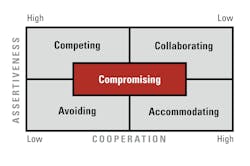In every human mind, the definition of success combines two factors: assertiveness and cooperation — the desire to complete a task versus the desire to maintain or improve a relationship.
To understand a problem, you have to understand it from the other person’s point of view. Let’s look at how people define success in five different ways:
Competing. This is your standard “I win, you lose” view of the world. On its face, success is defined in terms of sport. The score at the end determines who won and who lost. A competitive win in and of itself is not a bad thing. There is a time and place for competition. Winning in the right circumstance can be exhilarating. We all crave being the best at something.
A competition-style worldview can be felt by service advisors and customers at inappropriate times. This can be customers who don’t care about your business — only their interests and satisfaction. Or it can be advisors who view sales as a contest of will, and ultimately create buyer’s remorse. People who sell things just to get a spiff fall into this category, as well.
Collaborating. Collaboration was touted as the preferred method of retail business for at least two decades. It was the shiny new idea that deserved its time in the sun. Components of win/win include making the customer part of the decision and helping the service advisor understand the difference between “need” and “suggest.”
Because it was a new idea for retail at the time, it was slathered over everything like a bad paint job. But collaboration can cost the one thing you never get back: time. Not every situation deserves collaboration. It shouldn’t take 20 minutes to suggest an air filter. The juice isn’t worth the squeeze.
Collaboration is only appropriate when both sides are willing to push through pain points. Collaboration is 50/50 sweat because there is no compromise.
Compromising. Randomly discounting work to get a sale is a recipe for disaster. One, it teaches customers that all prices are negotiable. Two, it teaches employees that all pricing is negotiable as long as you get a sale. When compromise is the go-to tactic in retail, profitability is always the loser. The customer and employee both get what they want and the business gets nothing.
Compromising is an easy out for employees. If allowed in a store, it becomes very difficult to remove because it’s reinforced by both participants as a successful tactic. Compromise always ignores the “third way,” which is, “What solution is possible without discounting?”
We can compromise in other areas of a retail environment, but sacrificing gross profit for empty sales is a short-term and long-term disaster outside of a very narrow scope of intended results.
Avoiding. Believe it or not, avoidance of sales is common in the tire and automotive space and in the minds of certain people. It takes on many forms. Talking through a sale is common, where an advisor misses the cues to close. Providing benefits a customer isn’t interested in also gives customers ammunition for a ”no” later in the conversation.
Recognizing a vehicle when it pulls into the parking lot and disappearing from the showroom to let the new person deal with the owner of the vehicle is also problematic. Avoidance is seen as a victory because the advisor believes a win isn’t possible.
Accommodating. This tactic of success involves self-sacrifice. It can appear in hero syndrome-driven situations where the company goes so far above and beyond the normal scope of business that it is unsustainable in the long term.
Heroes die at the end of stories. They don’t always live happily ever after. Heroes are made in moments, not on a day-to-day basis. Hero syndrome accommodation creates burnout. Too much at stake every day will cause the best of your employees to crash to the ground, often creating a crater too big to climb out.
Sometimes it’s hard to see why employees or customers do what they do. But no one goes to work with the intent of failing. In fact, what you view as a failure may quietly be a win for the other person.
It’s not a secret that open, honest communication is the key. But the key must fit the lock. There is no one way — no script or trick. The strategy of understanding the vehicle’s problem and the customer’s problem goes a long way in solving retail’s biggest issue, which is trust.
About the Author

Dennis McCarron
Dennis McCarron is a partner at Cardinal Brokers Inc., one of the leading brokers in the tire and automotive industry (www.cardinalbrokers.com.) To contact McCarron, email him at [email protected].
